How can signs made by Precision Sign and Graphics help my business?
Your image and how you represent your company is one of the most important aspects of business and of how customers and prospects identify you. Most people make decisions based on the look of your business image.
What if I don’t know what I want?
You are not alone. Many people come to us with a skill or talent to produce a quality product or provide an outstanding service, yet they have absolutely no design abilities or creativity and they openly (humbly) admit it. Great! because I can’t replace my radiator on my car either. We all do our parts to make the world go round’. Our part is to make your business look good! We will ask questions and provide recommendations to produce a product that “works” for you and your business.
How much does it cost?
Naturally there is a wide variety of products making an equally wide variety of costs. Quotes are provided up front so there are no surprises! We are always happy to offer you options to meet your budget.
How long will my sign last?
We have many levels of materials to choose from. We use some of the best materials in the industry: 3M, Avery, Gator Foam, Orajet, etc. If you only need a quick sign that will be taken down after a few weeks or months, we can make your sign in a less expensive material. If you need it to last a few years, we will make it with a better grade of material to withstand the elements for the time period you need it to last. If you need it to last 5-7 years or longer, we will go with some of the best material available on the market today and you will be able to enjoy your signage for years and years to come.
How do I know if I’m going to like the design or even the finished product?
Clients are never surprised with the final product because we provide a full color proof of what it will look like before anything goes to final production. In most cases, we will email the proof for your approval. If a change is made, we will provide another proof to insure your satisfaction.
Can I approve the sign before it’s made?
Absolutely. Before we begin production, we require your approval of the artwork, colors, spelling, and layout. Once you are satisfied, we begin producing your sign. This way, we’re both clear on what we’re producing.
How fast is your average job being completed?
The turnaround time for your average sign varies based on your specific needs. We keep all the major materials in stock because we understand our clients needs are sometimes more urgent and we need to have everything in place and ready to go. That’s how we’re able to crank out a job with a very short notice. We also try to work with suppliers that are close and/or deliver next day, so we can get the rush jobs done if we need to.
How do I submit artwork / files?
We work with most professional design applications including Corel Draw, Adobe Photoshop / Illustrator, etc. If we’re “cutting” the lettering or logo out, we will be needing a Vector File, otherwise we can digitize (or Vectorize) the artwork you provide us in a JPEG, TIFF, PSD, GIF, etc. at an additional charge. You can email us your “print ready” or “cut ready” artwork, mail us a CD-R, CD-RW, DVD or USB flash drive or upload your file to our website. Please be sure that artwork is sent “high resolution”. If you have questions concerning your artwork or need help uploading, feel free to contact us by phone or email.
What resolution is acceptable for artwork submitted?
If sending your artwork in “real size”, please send your work 150 dpi. We can also work with a one-inch-to-one-foot ratio (Example: if the art is to be 6 feet long and 4 feet tall, the submitted artwork should be 6 inches long and 4 inches tall) at 300 dpi.
What is dpi?
Dpi is the standard of measurement for the resolution of images that describes the number of dots per inch (dpi) that are used to create an image. The higher the dpi, the higher the resolution which translates to better quality of your final product.
What is the difference between vector and bitmap images and which is better?
Vector and bitmap images are the two major graphic types. Both types are made up of many individual objects, and both respond differently when enlarged and/or reduced to produce different sizes of images. We can use both types of files, however we prefer vector files and we can change sizes easily without sacrificing quality using original vector formats. Vector images can be output at the highest quality in any scale because they are made of lines and panels rather than pixels or dots. Vector images are resolution independent. Common vector formats are eps, ai and pdf. These formats are available in most graphics programs.
A bitmap image (also called a raster image) is made of pixels (sometimes referred to as dots). The number of pixels in one square inch of an image is called the dpi (dots per inch) and is known as the resolution of the image (Example: 150 dpi means that the image has 150 dots per square inch within that image). Quite simply, the larger number of dots you have in your image produces a higher quality of reproduction. Bitmap images loose quality when the are re-sized from their original size and must be created with consideration for their output use. Bitmap images should be built at 150 dpi if they are built at the actual finished size. You can build the bitmap files at a smaller proportional size than the final usage size, but you must increase the resolution accordingly. For instance, if you build your file at a ratio of 1 inch = 1 foot, you should build the file at 300 dpi. In this case, you would build a 2 inch x 2 inch file at 300 dpi to print a resulting 2 foot x 2 foot image at 150 dpi. Common bitmap-based formats are jpeg, jpg, gif, tiff, png, pict and bmp. Although vector image is the preferred format for submitting artwork, it is not as common for non- designers and bitmap images at the correct resolution can be substituted.
Larger resolution files also use more bytes of memory & sometimes require special methods to transfer the images. Many graphic files become too large for standard email servers to upload so contact us if you need to get us a larger file.
How do I care for my wrapped vehicle?
The best way to clean a wrap is by hand, with a mild detergent and water. Use a soft cloth or sponge and a detergent that is specifically made for washing cars. You can hand wash a wrap the same way that you hand wash a painted car. First you will want to rinse the vehicle with clean water.
Next, gently apply a mild soapy solution beginning from the top of the vehicle and working your way down. Avoid any unnecessary scrubbing on the film surface. Rinse thoroughly with clean water when finished. Allow to dry naturally or dry lightly with a chamois or soft towel, being careful not to lift the edges.
Will a vehicle wrap damage my paint?
Absolutely not. A wrap actually temporarily protects your vehicle’s paint. Before a wrap is applied to a vehicle, the surface is thoroughly cleaned to remove any debris. The vinyl wrap is then carefully applied to the vehicle, putting a protective barrier between your vehicle and the earth’s elements.
Wraps won’t protect your vehicle from accidents, dings, or other damage. A wrap also should not be applied to paint that is not factory original because the often will lift aftermarket paint from the surface of the car upon removal. However, when you remove a wrap from the surface of a factory original painted surface, you may find that there are significantly fewer scratches and chips than if you hadn’t wrapped the vehicle.
What types of vehicles can you wrap?
We can wrap every type of vehicle from cars, vans and trucks to boats, golf carts, and ATV’s. Our experienced installers can turn any make and model of vehicle into a mobile advertising machine, or simply change the color and add your personal designs and decals.
Why should I wrap my vehicle with advertising?
Vinyl wrap advertising is the simplest way to advertise your business to a huge audience, all day every day. Whether you are parked in a busy shopping center or driving along a busy highway, your vehicle is advertising for you.
It offers one of the greatest returns on investment for your advertising dollars, unlike internet, TV or radio ads. A wrapped vehicle can generate between 30,000 and 70,000 impressions per day… that translates to increased brand awareness and new leads coming straight to your front door.
Why are some shops quoting me less than others to wrap my car?
There are a number of reasons why one shop may quote higher or lower, turnaround times can be a direct reflection of these same factors. With the vast variety of materials available on the market, there is a wide variety in quality and price. As with everything you get what you pay for.
Wraps have many different factors that need to be considered before pricing. Some of these are: the type and brand of the material used, does the project require a design, or is it a color change only. How many square feet of material will be used? How complex is the vehicle or item to be wrapped, does it have many curved areas and difficult corners, edges, etc. Are the bumpers included in the wrap estimate or quoted separate?
How is the wrap to be installed? Are all bumpers, mirrors, door handles and other accessories removed or cut around? There is a multiple of different variables that will determine the quality of material and workmanship when pricing your vehicle, wall, floor or storefront wrap.


